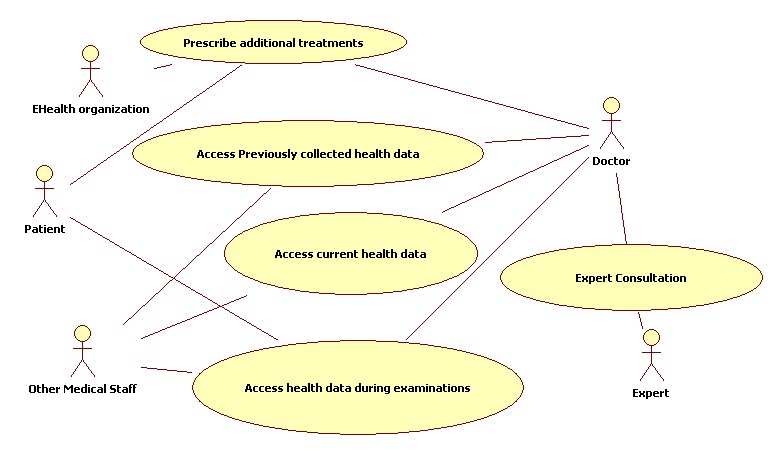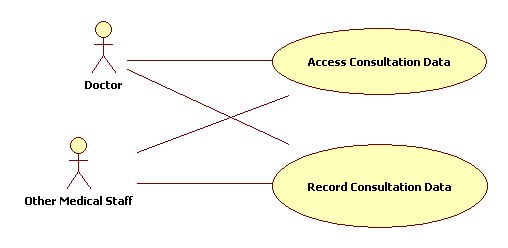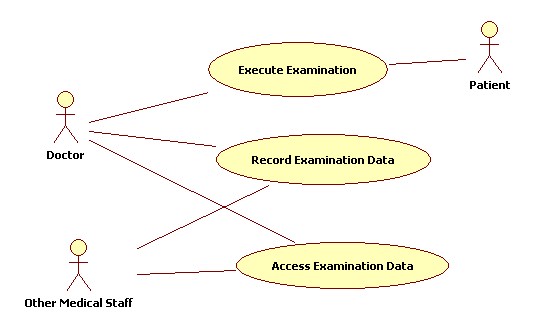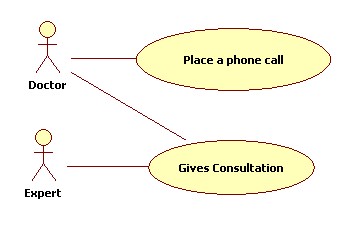Difference between revisions of "Mobile eHealth MeH (PESOS 2012)"
Berardinelli (talk | contribs) |
Berardinelli (talk | contribs) |
||
| Line 13: | Line 13: | ||
|- style="background:#f0f0f0; color:black" | |- style="background:#f0f0f0; color:black" | ||
! UniqueID | ! UniqueID | ||
| − | || | + | ||RD-BG-01 |
|- style="background:white; color:black" | |- style="background:white; color:black" | ||
| Line 25: | Line 25: | ||
|- style="background:white; color:black" | |- style="background:white; color:black" | ||
! Description | ! Description | ||
| − | | The system shall be able to reduce the overall duration of healthcare activities through ubiquitous and immediate access to | + | | The system shall be able to reduce the overall duration of healthcare activities through ubiquitous and immediate access to Patient data. |
| + | Patient data shall be ubiquitously available for the Doctor for further examinations. | ||
|- style="background:white; color:black" | |- style="background:white; color:black" | ||
| Line 33: | Line 34: | ||
|- style="background:white; color:black" | |- style="background:white; color:black" | ||
! Involved Stakeholders | ! Involved Stakeholders | ||
| − | | Doctors, Patients | + | | Doctors, Patients |
|- style="background:white; color:black" | |- style="background:white; color:black" | ||
| Line 40: | Line 41: | ||
|- style="background:white; color:black" | |- style="background:white; color:black" | ||
| − | ! | + | ! Supporting Materials |
| − | | | + | | [http://code.google.com/a/eclipselabs.org/p/mobile-ehealth-case-study/] |
| + | |||
|- style="background:white; color:black" | |- style="background:white; color:black" | ||
| Line 50: | Line 52: | ||
{| style="background:#cccc99;color:black;width:80%;" border="1" cellpadding="5" cellspacing="0" align="center" | {| style="background:#cccc99;color:black;width:80%;" border="1" cellpadding="5" cellspacing="0" align="center" | ||
| − | |+ Table BG2. Business Goal | + | |+ Table BG2. Business Goal RD-BG-02 |
!Field !! Description | !Field !! Description | ||
|- style="background:#f0f0f0; color:black" | |- style="background:#f0f0f0; color:black" | ||
! UniqueID | ! UniqueID | ||
| − | || | + | ||RD-BG-02 |
|- style="background:white; color:black" | |- style="background:white; color:black" | ||
| Line 67: | Line 69: | ||
|- style="background:white; color:black" | |- style="background:white; color:black" | ||
! Description | ! Description | ||
| − | | The system shall facilitate the ubiquitous access to expert consultancy whenever a doctor working for a diagnosis for a specific patient needs it | + | | The system shall facilitate the ubiquitous access to expert consultancy whenever a doctor working for a diagnosis for a specific patient needs it. |
|- style="background:white; color:black" | |- style="background:white; color:black" | ||
| Line 75: | Line 77: | ||
|- style="background:white; color:black" | |- style="background:white; color:black" | ||
! Involved Stakeholders | ! Involved Stakeholders | ||
| − | | Doctors | + | | Doctors |
|- style="background:white; color:black" | |- style="background:white; color:black" | ||
| Line 83: | Line 85: | ||
|- style="background:white; color:black" | |- style="background:white; color:black" | ||
! Supporting Material | ! Supporting Material | ||
| − | | | + | | [http://code.google.com/a/eclipselabs.org/p/mobile-ehealth-case-study/] |
|- style="background:white; color:black" | |- style="background:white; color:black" | ||
| Line 93: | Line 95: | ||
{| style="background:#cccc99;color:black;width:80%;" border="1" cellpadding="5" cellspacing="0" align="center" | {| style="background:#cccc99;color:black;width:80%;" border="1" cellpadding="5" cellspacing="0" align="center" | ||
| − | |+ Table BG3. Business Goal | + | |+ Table BG3. Business Goal RD-BG-03 |
!Field !! Description | !Field !! Description | ||
| Line 102: | Line 104: | ||
|- style="background:white; color:black" | |- style="background:white; color:black" | ||
! Short Name | ! Short Name | ||
| − | | | + | | Adaptation to heterogeneous execution context. |
|- style="background:white; color:black" | |- style="background:white; color:black" | ||
| Line 110: | Line 112: | ||
|- style="background:white; color:black" | |- style="background:white; color:black" | ||
! Description | ! Description | ||
| − | | The system shall be able to | + | | The system shall be able to maintain a certain Quality of Service (intended as a combination of non-functional properties like performance, reliability, availability etc) according to some Service Level Agreement between system users (Doctors) and the provided software service. |
|- style="background:white; color:black" | |- style="background:white; color:black" | ||
| Line 118: | Line 120: | ||
|- style="background:white; color:black" | |- style="background:white; color:black" | ||
! Involved Stakeholders | ! Involved Stakeholders | ||
| − | | Doctors | + | | Doctors, EHealth Organization |
|- style="background:white; color:black" | |- style="background:white; color:black" | ||
| Line 126: | Line 128: | ||
|- style="background:white; color:black" | |- style="background:white; color:black" | ||
! Supporting Material | ! Supporting Material | ||
| − | | | + | | [http://code.google.com/a/eclipselabs.org/p/mobile-ehealth-case-study/] |
|- style="background:white; color:black" | |- style="background:white; color:black" | ||
Revision as of 12:06, 17 April 2012
Contents
Business Goals and Domain Assumptions
In the following sections will be reported the Business Goals and the Domain Assumptions for the current case study.
Business Goals
| Field | Description |
|---|---|
| UniqueID | RD-BG-01 |
| Short Name | Ubiquitous and Immediate Access to Patient Data |
| Type | Business Goals. |
| Description | The system shall be able to reduce the overall duration of healthcare activities through ubiquitous and immediate access to Patient data.
Patient data shall be ubiquitously available for the Doctor for further examinations. |
| Rationale | Improve the effectiveness and reliability of healthcare activities. Reduce costs of healthcare activities. |
| Involved Stakeholders | Doctors, Patients |
| Conflicts | None |
| Supporting Materials | [1]
|
| Priority of accomplishment | Must have. |
| Field | Description |
|---|---|
| UniqueID | RD-BG-02 |
| Short Name | Ubiquitous Access to Expert Consultancy |
| Type | Business Goals. |
| Description | The system shall facilitate the ubiquitous access to expert consultancy whenever a doctor working for a diagnosis for a specific patient needs it. |
| Rationale | Improve the effectiveness and reliability of healthcare activities. Reduce costs of healthcare activities. |
| Involved Stakeholders | Doctors |
| Conflicts | None |
| Supporting Material | [2] |
| Priority of accomplishment | Must have. |
| Field | Description |
|---|---|
| UniqueID | EHEALTH-BG-03 |
| Short Name | Adaptation to heterogeneous execution context. |
| Type | Business Goals. |
| Description | The system shall be able to maintain a certain Quality of Service (intended as a combination of non-functional properties like performance, reliability, availability etc) according to some Service Level Agreement between system users (Doctors) and the provided software service. |
| Rationale | Improve the effectiveness, reliability and duration of healthcare activities. Reduce costs of healthcare activities. |
| Involved Stakeholders | Doctors, EHealth Organization |
| Conflicts | None |
| Supporting Material | [3] |
| Priority of accomplishment | Must have. |
Domain Assumptions
| Field | Description |
|---|---|
| UniqueID | EHEALTH-DA-01 |
| Short Name | Device Integration and Vertical integration |
| Type | Domain assumption |
| Description | The system shall consist of devices fully integrated in service-oriented architectures, that is, it shall be vertically integrated. For different kind of devices different embedded SOAs have to be developed including respective standards. The system shall provide a dependable device integration which will enable the data from different devices to be accessible in a dependable way. The complex diagnostic workflow system shall provide dependable access when the devices are used during a diagnosis or for monitoring a patient’s health status, that is, after the health data is integrated into application specific workflows, it shall be accessible in a dependable way.
In practice, there exist domain specific standards or best practices for device handling, such as the Microsoft Connected Health Framework (CHF) or the Eclipse OpenHealthFramework. Such standards are of great importance to the developers of applications for devices. These standards often contain domain specific information models and/or protocols and hence substantially facilitate the application development and interoperability. |
| Rationale | Enforce overall system integration, dependability and adaptability |
| Involved Stakeholders | Doctors, Other Medical Staff |
| Conflicts | None |
| Supporting Material | None |
| Priority of accomplishment | Could have. |
| Field | Description |
|---|---|
| UniqueID | EHEALTH-DA-02 |
| Short Name | Compliance to Health Privacy and Security requirements |
| Type | Domain assumption |
| Description | The system should be compliant to security and privacy functions regarding treatments, services, workflows and individual services interactions. For example, in the Health domain the US-regulations are defined within the HealthPortability and Accounting Act (HIPAA) Privacy and Security rules. This standard covers all health stakeholders: individuals including doctors, nurses, pharmacists, physical therapists and organisations including hospitals, laboratories, pharmacies, nursing facilities and more generally, all health services and clearinghouses. The privacy and security rules require safeguarding all PHI (e.g. Protected Health Information). |
| Rationale | Effectively manage security and privacy policies, by relying on recognized standards in the world of healthcare. Without this requirement, a
specific security and privacy policy will have to be defined. |
| Involved Stakeholders | Doctors, Patients, Other Medical Staff, EHealth Organization |
| Conflicts | None |
| Supporting Material | Some documents that illustrate and explain this requirement: |
| Priority of accomplishment | Should have |
Domain Analysis
Strategic Dependency Model and Context Diagram
The SDD figure illustrates the strategic dependency diagram of the case study. The diagram puts in evidence the business goals shared among the related actors. For example, in the diagram we can note that the Doctor makes a diagnosis for the Patient, and plans examinations and treatments which are managed by the EHealth Organizations. He/She can also request a consultancy to some experts. Moreover, the medical staff can monitor patient’s data.
The following figure illustrates the context diagram of the current case study. In the context diagram, all the actors that appear in the business goals and scenarios are agents.
Domain Model
The figure below illustrates the domain model of the current case study. The model is represented using a UML notation. In particular the model shows the entities of the scenario, the actors and the relationship among them.
Scenarios
The following figure shows the general use-case diagram for the EHealth case study.
| Field | Description |
|---|---|
| UniqueID | EHEALTH-S-01 |
| Short Name | Access previously collected health data |
| Related To | EHEALTH-BG-01, EHEALTH-DA-02 |
| Involved Actors | Doctor, Other Medical Staff |
| Detailed Operational Description | During the medical examination, the doctor or other medical staff may need access to the patient’s previously recorded and now archived health data (that is, blood test results, X-ray images, etc.) which were either recorded in the same location or at a different place. For instance, this data might have been recorded at a different hospital (which possibly belongs to a different hospital chain). |
| Problems and Challenges | The problems and challenges related to this scenario are the following:
granted access rights
|
| Additional Material | None |
| Field | Description |
|---|---|
| UniqueID | EHEALTH-S-02 |
| Short Name | Access current health data |
| Related To | EHEALTH-BG-01, EHEALTH-DA-02 |
| Involved Actors | Doctor, Other Medical Staff |
| Detailed Operational Description | The doctor also needs access to the data recorded online during the consultation by either the doctor himself or his assistants. He may, in addition, need data that was recorded shortly before the consultation, or that was collected in the hospital or at home during a long-term monitoring with a mobile diagnostic device like, for instance, an ambulatory blood pressure unit. It is even conceivable that the doctor would use diagnostic data received from nanobots (that is, agent-like devices of nanometre-size brought into a human body for diagnosis or even for therapy). In addition, whatever kind of data he is using, the doctor should be supported in his analysis by expert systems and databases. |
| Problems and Challenges | The problems and challenges related to this scenario are the following:
|
| Additional Material | Sub use case: |
| Field | Description |
|---|---|
| UniqueID | EHEALTH-S-03 |
| Short Name | Access health data during examinations |
| Related To | EHEALTH-BG-01, EHEALTH-BG-04, EHEALTH-DA-02 |
| Involved Actors | Doctor, Patient, Other Medical Staff |
| Detailed Operational Description | To reach a diagnosis during a complex examination, the doctor may need to use several devices in several locations. The devices could be a general-purpose handheld computer or a specific integrated device for medical diagnostics, for instance, an X-ray device. They are often located in the same hospital, but also their usage in a different place, e.g. the patient’s home, is conceivable. For the execution of patient checks a doctor could exploit different devices. In this case, their status has to be properly aligned. |
| Problems and Challenges | The problems and challenges related to this scenario are the following:
|
| Additional Material | Sub use-case: |
| Field | Description |
|---|---|
| UniqueID | EHEALTH-S-04 |
| Short Name | Expert Consultation |
| Related To | EHEALTH-BG-02, EHEALTH-BG-05, EHEALTH-DA-02 |
| Involved Actors | Doctor, Expert |
| Detailed Operational Description | The doctor might need to call a colleague for consultation or to evaluate a specific result. To this end, the doctor has access to directories and can place a phone call by one mouse-click from just the computer he uses at that moment. This feature may be taken a step further to collaborative environments and expert call centres. |
| Problems and Challenges | The problems and challenges related to this scenario are the following:
|
| Additional Material | Sub use-case:
|






